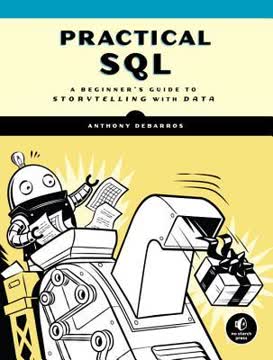نکات کلیدی
1. تسلط بر اکسل برای تحلیل و تجزیه و تحلیل دادهها
اکسل ابزاری بسیار چندمنظوره است که نقش محوری در فرآیند تحلیل دادهها برای اکثر شرکتها ایفا میکند.
قدرت و فراگیری اکسل. اکسل بهعنوان پرکاربردترین ابزار تحلیلی در کسبوکار به دلیل چندمنظوره بودن و دسترسی آسان، باقی مانده است. این نرمافزار مجموعهای از ویژگیهای قدرتمند برای دستکاری، تحلیل و تجزیه و تحلیل دادهها ارائه میدهد:
- عملکردهای اصلی: مرتبسازی، فیلتر کردن، فرمتبندی شرطی، نمودارها، جداول محوری
- قابلیتهای تحلیل داده: تحلیلهای فرضی، توابع آماری، مدلسازی داده
- ابزارهای تجزیه و تحلیل: نمودارهای دایرهای، نقشهها، شاخصهای کلیدی عملکرد، سلسلهمراتبها، قابلیتهای جستجوی عمیق
محدودیتهای اکسل. در حالی که اکسل برای تحلیلگران داده ضروری است، مهم است که محدودیتهای آن را نیز بشناسید:
- چالشهای همکاری
- مشکلات یکپارچگی داده با نسخههای متعدد
- محدودیتهای مقیاسپذیری برای مجموعههای داده بسیار بزرگ
برای به حداکثر رساندن پتانسیل اکسل، بر تسلط بر فرمولها، تکنیکهای وارد کردن داده و ویژگیهای پیشرفته مانند PowerPivot و PowerQuery تمرکز کنید.
2. تسلط بر SQL برای دسترسی و دستکاری پایگاههای داده رابطهای
SQL زبان اصلی است که برای درخواست اطلاعات از یک پایگاه داده استفاده میشود و در همهجا وجود دارد.
فراگیری و قدرت SQL. زبان پرسوجوی ساختاریافته (SQL) استانداردی برای تعامل با پایگاههای داده رابطهای است که مقادیر زیادی از دادههای تجاری را ذخیره میکند. مزایای کلیدی SQL شامل:
- قابلیت پرسوجو و بهروزرسانی دادهها در پایگاههای داده
- بازیابی و تحلیل سریع دادهها
- ارتباط دادهها از جداول مختلف با استفاده از JOIN
- مدیریت مجموعههای داده بزرگ و کاربران همزمان
اصول اولیه SQL. برای تسلط بر SQL، بر یادگیری موارد زیر تمرکز کنید:
- زبان دستکاری داده (DML): SELECT، INSERT، UPDATE، DELETE
- زبان تعریف داده (DDL): CREATE، ALTER، DROP
- JOINها، تجمیعها و زیرپرسوجوها
- اصول طراحی پایگاه داده و نرمالسازی
در حالی که طعمهای مختلفی از SQL وجود دارد (مانند MySQL، PostgreSQL، Oracle)، مفاهیم اصلی در تمام پلتفرمها یکسان باقی میماند. بهطور منظم تمرین نوشتن پرسوجوها را انجام دهید تا مهارتهای خود را تقویت کنید.
3. درک انبار داده برای تحلیلهای مقیاس سازمانی
انبار داده بهویژه مرتبط است زیرا دادهها و اطلاعات از منابع داده تولیدی ناهمگن استخراج میشوند، چه در زمان تولید و چه در مراحل دورهای، که این امر انجام پرسوجوها بر روی دادههایی که در ابتدا از منابع مختلف آمدهاند را سادهتر و کارآمدتر میسازد.
اصول انبار داده. انبار داده یک مخزن متمرکز است که دادهها را از منابع مختلف در یک سازمان تجمیع میکند. مزایای کلیدی شامل:
- استانداردسازی دادهها در سراسر بخشها
- حفظ دادههای تاریخی برای تحلیل روندها
- بهبود کیفیت و یکپارچگی داده
- افزایش عملکرد پرسوجو برای تحلیلهای مقیاس بزرگ
مدلسازی بعدی. درک مدلسازی بعدی برای طراحی مؤثر انبار داده بسیار مهم است:
- جداول واقعیت: شامل اندازهگیریهای کمی
- جداول بعدی: ارائه زمینه و ویژگیهای توصیفی
- طرح ستارهای: ساختاری رایج با یک جدول واقعیت مرکزی که توسط جداول بعدی احاطه شده است
با فرآیندهای ETL (استخراج، تبدیل، بارگذاری) و معماری انبار داده آشنا شوید تا بهتر درک کنید که چگونه دادهها از سیستمهای منبع به ابزارهای تحلیلی منتقل میشوند.
4. یادگیری برنامهنویسی برای خودکارسازی و بهبود تحلیل داده
یادگیری کدنویسی بهخصوص آسان نیست، اما به همین دلیل است که بسیار ارزشمند است. حتی اگر برنامهای برای تبدیل شدن به یک توسعهدهنده نرمافزار ندارید، چند هفته یا ماه را صرف یادگیری کدنویسی کنید و میتوانم تضمین کنم که توانایی شما در حل مشکلات و عیبیابی را تقویت خواهد کرد.
مزایای برنامهنویسی برای تحلیل داده. یادگیری کدنویسی قابلیتهای یک تحلیلگر داده را با امکان:
- خودکارسازی وظایف تکراری
- ایجاد ابزارهای تحلیلی سفارشی
- مدیریت تبدیلهای پیچیده داده
- پیادهسازی مدلهای آماری پیشرفته
شروع با برنامهنویسی. با زبانی که برای تحلیل داده مناسب است، مانند Python یا R، شروع کنید. بر روی موارد زیر تمرکز کنید:
- نحو و ساختارهای داده پایه
- کتابخانههای دستکاری داده (مانند pandas برای Python)
- ابزارهای تجزیه و تحلیل داده (مانند matplotlib، ggplot2)
- بستههای تحلیل آماری
با اسکریپتهای ساده شروع کنید و به تدریج برنامههای پیچیدهتری بسازید. تمرین مداوم و کاربرد آن در مسائل دنیای واقعی کلید توسعه مهارتهای برنامهنویسی است.
5. توسعه مهارتهای تحلیل پیشبینی برای بینشهای آیندهنگر
تحلیل پیشبینی دیگر یک داستان علمی تخیلی نیست — این چیزی است که در حال حاضر در حال وقوع است و به احتمال زیاد به شرکتی نزدیک به شما خواهد آمد.
اهمیت تحلیل پیشبینی. این شکل پیشرفته از تحلیل، از دادههای تاریخی برای پیشبینی روندها و رفتارهای آینده استفاده میکند و به سازمانها این امکان را میدهد که:
- تصمیمات مبتنی بر داده اتخاذ کنند
- خطرات و فرصتهای بالقوه را شناسایی کنند
- فرآیندهای تجاری را بهینهسازی کنند
- مزایای رقابتی کسب کنند
تکنیکهای کلیدی پیشبینی. با رویکردهای مدلسازی پیشبینی رایج آشنا شوید:
- تحلیل رگرسیون
- پیشبینی سریهای زمانی
- الگوریتمهای طبقهبندی
- روشهای خوشهبندی
یاد بگیرید که چگونه از ابزارهایی مانند R، Python یا نرمافزارهای تخصصی تحلیل پیشبینی استفاده کنید. بر درک مفاهیم آماری زیرین و نحوه تفسیر نتایج مدل برای ذینفعان تجاری تمرکز کنید.
6. سازگاری با فناوریهای نوظهور و روندهای صنعتی
این قویترین گونهها نیستند که زنده میمانند، نه هوشمندترینها. بلکه آنهایی که بیشتر به تغییرات سازگار میشوند، زنده میمانند.
پذیرش تغییر. حوزه تحلیل داده به سرعت در حال تحول است. برای باقی ماندن در صحنه، به موارد زیر توجه کنید:
- نظارت بر روندهای صنعتی و فناوریهای نوظهور
- یادگیری مداوم و بهروزرسانی مهارتهای خود
- آزمایش با ابزارها و تکنیکهای جدید
- شرکت در کنفرانسها و رویدادهای شبکهسازی
روندهای کلیدی برای نظارت. به تحولات در زمینههای زیر توجه کنید:
- فناوریهای داده کلان (مانند Hadoop، Spark)
- یادگیری ماشین و هوش مصنوعی
- پلتفرمهای تحلیل ابری
- مقررات حریم خصوصی و امنیت داده
ذهنیت رشد را پرورش دهید و آماده باشید تا مهارتهای خود را با ظهور فناوریهای جدید و تغییر نیازهای تجاری سازگار کنید.
7. پرورش ذهنیت تحلیلگر داده برای موفقیت شغلی
بهعنوان یک تحلیلگر داده در سازمان خود، ممکن است بهطور صریح مسئولیت بازی کردن نقش DBA را نداشته باشید، اما هنوز هم ممکن است برای شما مفید باشد که درک ابتدایی از مفاهیم DBA بهطور کلی داشته باشید. این امر شما را چندمنظورهتر و در نتیجه در صنعت قابل فروشتر میسازد.
درک جامع. تحلیلگران داده موفق، درک وسیعی از اکوسیستم دادهها توسعه میدهند:
- منابع داده و روشهای جمعآوری
- فناوریهای ذخیرهسازی و پردازش
- تکنیکهای تحلیل و تجزیه و تحلیل
- کاربردهای تجاری و فرآیندهای تصمیمگیری
ویژگیهای کلیدی تحلیلگران داده:
- کنجکاوی و ذهنیت حل مسئله
- مهارتهای ارتباطی قوی
- توجه به جزئیات و کیفیت داده
- ملاحظات اخلاقی در مدیریت داده
بهطور مداوم دانش خود را فراتر از نقش اصلی خود گسترش دهید. درک کنید که کار شما چگونه در جریان کلی تحلیل دادهها و تأثیر آن بر نتایج تجاری قرار میگیرد. مهارتهای نرم مانند مدیریت پروژه و ارتباط با ذینفعان را توسعه دهید تا ارزش خود را برای سازمانها افزایش دهید.
آخرین بهروزرسانی::
FAQ
1. What’s "A Game Plan for Success in Data Analytics" by Fru Nde about?
- Beginner’s Guide to Data Analytics: The book provides a high-level overview of the essential tools, concepts, and skills needed to start a career in data analytics, especially for beginners.
- 5-Point Game Plan: It introduces a structured five-step approach: Master Excel, Conquer SQL, Tame Data Warehousing, Pick Up Coding, and Continue Adapting.
- Focus on Practical Skills: Rather than deep technical tutorials, the book offers practical advice, industry context, and curated resources for self-study.
- Career Orientation: It targets aspiring data professionals (Data Ninjas), helping them understand roles, required skills, and industry expectations.
2. Why should I read "A Game Plan for Success in Data Analytics" by Fru Nde?
- Entry-Level Friendly: The book is designed for newcomers with little or no experience in data analytics, making it accessible and unintimidating.
- Career Advancement: It provides actionable steps and resources to help readers land their first job, make a career change, or progress in their current roles.
- Comprehensive Overview: Readers gain a broad understanding of the data analytics landscape, including tools, roles, and industry trends.
- Resource-Rich: Each chapter ends with curated resources for further learning, making it a practical guide for self-driven learners.
3. Who is the ideal reader for "A Game Plan for Success in Data Analytics" by Fru Nde?
- Aspiring Data Professionals: The book is aimed at those interested in starting a career in data analytics, regardless of technical background.
- Career Changers: Individuals looking to transition into data roles from other fields will find the guidance and resources especially helpful.
- Curious Learners: Anyone seeking to understand the basics of data analytics, tools, and industry expectations will benefit.
- Entry-Level Candidates: The content is tailored for those at the beginning of their data journey, not for advanced practitioners.
4. What is the "5-Point Game Plan" outlined in "A Game Plan for Success in Data Analytics" by Fru Nde?
- Master Excel: Learn to use Excel for data manipulation, analysis, and presentation, as it remains a foundational tool in analytics.
- Conquer SQL: Gain proficiency in SQL to query, manage, and analyze data stored in relational databases.
- Tame Data Warehousing: Understand the basics of data warehousing, including architecture, dimensional modeling, and its role in consolidating data.
- Pick Up Coding: Develop basic programming skills to automate tasks, analyze data, and solve business problems.
- Continue Adapting: Embrace continuous learning and adaptability to keep up with evolving technologies and industry trends.
5. How does "A Game Plan for Success in Data Analytics" by Fru Nde define a "Data Ninja" and what roles do they play?
- Definition of Data Ninja: A Data Ninja is an entry-level, unspecialized individual who works with data to collect, organize, and interpret it for actionable insights.
- Versatile Skill Set: Data Ninjas are expected to be multi-skilled, using various tools and techniques to transform raw data into information.
- Industry Roles: They can work in diverse industries (healthcare, finance, retail, government, etc.) and perform roles such as data analyst, report writer, or business intelligence professional.
- Interpreter of Data: Data Ninjas act as interpreters, ensuring that data is accurately analyzed and communicated to support business decisions.
6. What are the key skills and tools recommended in "A Game Plan for Success in Data Analytics" by Fru Nde?
- Technical Skills: Proficiency in Excel, SQL, understanding of data warehousing concepts, and basic programming are emphasized.
- Soft Skills: Communication, critical thinking, business acumen, and attention to detail are highlighted as essential for success.
- Recommended Tools: The book suggests starting with Excel, SQL Server, and learning about data warehousing and programming languages.
- Continuous Learning: Emphasis is placed on ongoing training and practice, with resources provided for self-study.
7. How does "A Game Plan for Success in Data Analytics" by Fru Nde explain the importance of Excel for data professionals?
- Ubiquity and Versatility: Excel is widely used for data manipulation, analysis, and presentation, making it a must-know tool for data professionals.
- Core Functionalities: Features like sorting, filtering, pivot tables, charts, and the Analysis ToolPak are essential for analyzing and visualizing data.
- Limitations Acknowledged: The book discusses Excel’s drawbacks (e.g., collaboration, scalability, data integrity) and when to consider other tools.
- Integration with Power BI: It introduces Power BI as an extension of Excel’s capabilities for more advanced analytics and visualization.
8. What is SQL and why is it essential according to "A Game Plan for Success in Data Analytics" by Fru Nde?
- Definition and Ubiquity: SQL (Structured Query Language) is the standard language for querying and managing data in relational databases, used across industries and applications.
- Key Benefits: SQL enables efficient data retrieval, updates, and reporting, supports large datasets, and allows for concurrent multi-user access.
- Core Concepts: The book covers DML (Data Manipulation Language), DDL (Data Definition Language), DCL (Data Control Language), and TCL (Transaction Control Language).
- Relevance: Mastery of SQL is crucial for data professionals, as most organizational data resides in relational databases.
9. What is data warehousing and why should data professionals understand it, according to "A Game Plan for Success in Data Analytics" by Fru Nde?
- Centralized Data Repository: A data warehouse consolidates data from multiple sources, providing a single version of the truth for analysis and reporting.
- Architecture and ETL: Understanding the flow of data from source systems through ETL (Extract, Transform, Load) processes into the warehouse is key.
- Dimensional Modeling: The book introduces fact and dimension tables, explaining how dimensional modeling supports efficient querying and analysis.
- Business Impact: Data warehousing standardizes data, improves data quality, and enables historical analysis, making it vital for decision support.
10. Why does "A Game Plan for Success in Data Analytics" by Fru Nde emphasize learning programming for data analysis?
- Problem-Solving Tool: Programming enables automation, data manipulation, and the creation of custom solutions for complex business problems.
- Gateway to Advanced Analytics: As data tasks become more complex (e.g., big data, data science), programming skills become increasingly important.
- Recommended Approach: Start with beginner-friendly languages (e.g., VB.NET, Python), focus on concepts, and practice regularly to build competence.
- Broader Learning: Programming fosters computational thinking, creativity, and adaptability—skills valuable beyond just coding.
11. How does "A Game Plan for Success in Data Analytics" by Fru Nde address the need for continuous adaptation in the data field?
- Rapid Technological Change: The book highlights the fast pace of change in data tools, technologies, and methodologies.
- Predictive Analytics and Emerging Trends: It discusses the rise of predictive analytics, big data, and the importance of staying current with industry developments.
- Evolutionary vs. Revolutionary Change: Readers are encouraged to adapt to both incremental (evolutionary) and disruptive (revolutionary) changes in the field.
- Lifelong Learning: Emphasis is placed on curiosity, flexibility, and ongoing education to remain relevant and successful as a data professional.
12. What are the key takeaways, best quotes, and resources from "A Game Plan for Success in Data Analytics" by Fru Nde?
- Key Takeaways: Master foundational tools (Excel, SQL), understand data warehousing, learn programming, and commit to continuous learning and adaptation.
- Best Quotes: Notable quotes include “Numbers have an important story to tell. They rely on you to give them a clear and convincing voice.” (Stephen Few) and “It is not the strongest of the species that survives, nor the most intelligent that survives. It is the one that is most adaptable to change.” (Charles Darwin).
- Resource Lists: Each chapter ends with curated resources—websites, tutorials, books—for further study in Excel, SQL, data warehousing, and programming.
- Practical Advice: The book stresses the importance of communication, business understanding, and the ability to translate data into actionable insights.
نقد و بررسی
کتاب سرآغاز SQL عمدتاً نظرات مثبتی دریافت کرده و به خاطر رویکرد دوستانهاش برای مبتدیان و سبک سرگرمکنندهاش مورد ستایش قرار گرفته است. خوانندگان از توضیحات واضح و مثالهای عملی آن قدردانی میکنند. برخی به نحوۀ نگارش قدیمی و خطاهای فنی آن انتقاد کردهاند. این کتاب به شدت برای تازهکاران SQL توصیه میشود، اما ممکن است برای کسانی که به دنبال محتوای پیشرفته هستند مناسب نباشد. بسیاری از خوانندگان آن را لذتبخش و مؤثر برای یادگیری مفاهیم پایه SQL میدانند. برخی پیشنهاد میکنند که این کتاب بیشتر برای کاربران MySQL مناسب است و توصیه میکنند که مستندات سیستمهای پایگاه داده دیگر را بررسی کنند. بهطور کلی، این کتاب به عنوان نقطه شروع خوبی برای مبتدیان SQL در نظر گرفته میشود.
Similar Books












